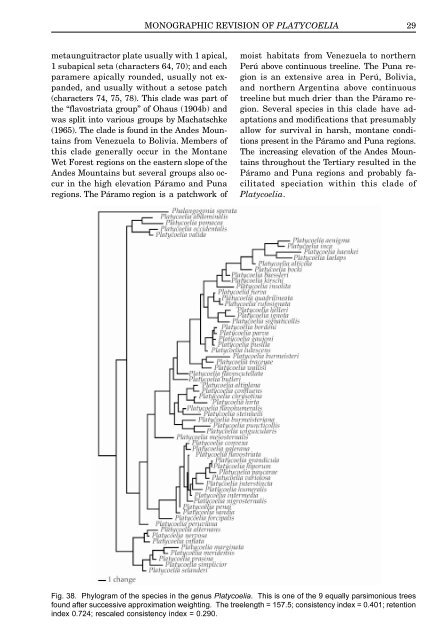Download full text (PDF 4.5 MB) - University of Nebraska State ...
Download full text (PDF 4.5 MB) - University of Nebraska State ...
Download full text (PDF 4.5 MB) - University of Nebraska State ...
Create successful ePaper yourself
Turn your PDF publications into a flip-book with our unique Google optimized e-Paper software.
metaunguitractor plate usually with 1 apical,<br />
1 subapical seta (characters 64, 70); and each<br />
paramere apically rounded, usually not expanded,<br />
and usually without a setose patch<br />
(characters 74, 75, 78). This clade was part <strong>of</strong><br />
the “flavostriata group” <strong>of</strong> Ohaus (1904b) and<br />
was split into various groups by Machatschke<br />
(1965). The clade is found in the Andes Mountains<br />
from Venezuela to Bolivia. Members <strong>of</strong><br />
this clade generally occur in the Montane<br />
Wet Forest regions on the eastern slope <strong>of</strong> the<br />
Andes Mountains but several groups also occur<br />
in the high elevation Páramo and Puna<br />
regions. The Páramo region is a patchwork <strong>of</strong><br />
MONOGRAPHIC REVISION OF PLATYCOELIA 29<br />
moist habitats from Venezuela to northern<br />
Perú above continuous treeline. The Puna region<br />
is an extensive area in Perú, Bolivia,<br />
and northern Argentina above continuous<br />
treeline but much drier than the Páramo region.<br />
Several species in this clade have adaptations<br />
and modifications that presumably<br />
allow for survival in harsh, montane conditions<br />
present in the Páramo and Puna regions.<br />
The increasing elevation <strong>of</strong> the Andes Mountains<br />
throughout the Tertiary resulted in the<br />
Páramo and Puna regions and probably facilitated<br />
speciation within this clade <strong>of</strong><br />
Platycoelia.<br />
Fig. 38. Phylogram <strong>of</strong> the species in the genus Platycoelia. This is one <strong>of</strong> the 9 equally parsimonious trees<br />
found after successive approximation weighting. The treelength = 157.5; consistency index = 0.401; retention<br />
index 0.724; rescaled consistency index = 0.290.
















